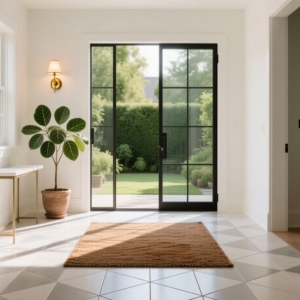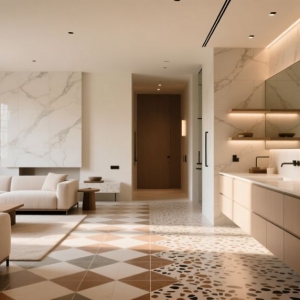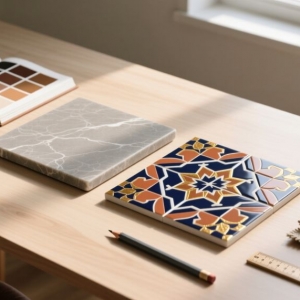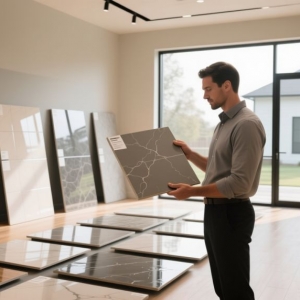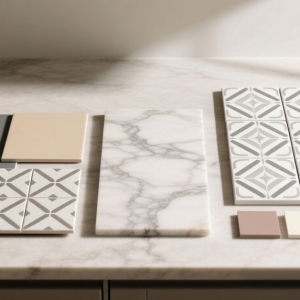Gone are the days when tiled interiors meant uniform floors, walls, and backsplashes in predictable, matching hues. Today, mixing and matching tiles is a creative way to bring individuality to any room. From kitchens to bathrooms to entryways, a thoughtful combination of tiles can transform a space into something vibrant, modern, and uniquely yours. The key is finding harmony—blending patterns, textures, and colors in a way that feels intentional rather than haphazard.
Crafting Harmony Through Contrast
A well-mixed tile design feels cohesive, even when the elements differ. The patterns or colors might vary, but they share a subtle connection—a shared tone, texture, or rhythm—that ties them together. This balance turns a space from chaotic to captivating.
High-quality tiles make this easier. Their consistent finishes and precise details allow you to mix styles confidently without the result feeling overwhelming. For example, pairing a glossy ceramic floor with textured subway wall tiles creates a dynamic contrast while maintaining unity. Visiting a tile shop lets you see these combinations in action, helping you visualize how they’ll work in your space.
Begin with the Vibe
Before selecting tiles, decide on the mood you want to evoke. Are you aiming for a soothing, spa-like retreat? A cozy, rustic haven? Or a bold, artistic statement? This starting point shapes every choice, from colors to patterns to textures.
For a serene atmosphere, choose tiles with gentle contrasts, like pale blue walls paired with soft white floors. For a more dramatic effect, opt for opposing tones—deep charcoal against warm sand or black against light grey. Bringing samples of your home’s existing materials—paint chips, wood finishes, or textiles—to a tile shop can help you test combinations and ensure they align with your vision.
The Magic of Texture
Texture often trumps color in creating a compelling tiled space. A room with a single finish can feel one-dimensional, but blending smooth and tactile surfaces adds richness and depth.
In a bathroom, large, polished wall tiles paired with small, textured floor tiles create a balanced, practical design—matte surfaces reduce slipping in wet areas. In a kitchen, a reflective backsplash alongside a matte floor tile creates a subtle play of light and shadow. These shifts add sophistication without overwhelming the senses. A tile shop’s displays can show you how to layer textures for maximum impact.
Patterns with Purpose
Patterned tiles can steal the show, but they’re most effective when used strategically. Choose one standout pattern and pair it with simpler tiles to avoid visual clutter. A bold encaustic floor tile, for instance, pairs beautifully with plain wall tiles, while a decorative backsplash shines against sleek countertops.
Moderation is crucial—stick to two or three tile types per room to keep the design focused. Proportion also matters: large tiles make a space feel expansive, while smaller tiles or mosaics add texture and rhythm. Combining them thoughtfully, like using large floor tiles with a mosaic accent, creates a lively yet cohesive look. A tile shop’s room vignettes can inspire ideas for balancing patterns and proportions.
Color as the Foundation
Color ties the design together. Start with one primary hue to ground the space, then add one or two complementary or contrasting shades. Neutrals like beige or taupe pair well with natural materials like stone or wood, while greys harmonize with blues or whites for a modern feel. Black-and-white schemes are classic but need warm accents—like wooden shelves or brass fixtures—to feel inviting.
For a bold statement, use rich tones like ruby or teal in small areas, such as a feature wall or niche. These pops of color add depth without dominating. Exploring a tile shop’s color collections can help you find the perfect palette.
Anchoring the Space
Bold tile designs need a grounding element to keep them from feeling chaotic. A neutral floor or a plain wall acts as a visual breather, letting the eye rest and the statement tiles shine. Without this balance, a space can feel overly busy.
Think of tile design like storytelling: it needs both action and quiet moments. Neutral or understated tiles provide the calm that makes bold patterns stand out. A tile shop’s curated displays often showcase how designers use neutral tiles to anchor vibrant combinations.
Lighting’s Impact
Light shapes how tiles perform. Glossy tiles reflect light, opening up small spaces, while matte tiles soften the mood by absorbing it. When mixing finishes, consider how light changes throughout the day.
In a sunny kitchen, too many reflective tiles can create glare, while in a darker bathroom, glossy accents can brighten the space. Testing tile samples under different lighting at a tile shop helps you anticipate how they’ll look in your home.
Quality as the Backbone
High-quality tiles are the foundation of a successful mix. Their consistent colors, clean edges, and durable finishes ensure seamless combinations, whether you’re blending tiles from one collection or across brands. A tile shop’s full-room setups can demonstrate how quality materials elevate even the boldest designs.
Personal Expression
Mixing tiles is a chance to make a space your own. Whether you prefer subtle, monochromatic looks or vibrant, eclectic combinations, every tile should serve a purpose—adding texture, color, or calm. There’s no one-size-fits-all approach, but intentional choices always lead to a cohesive result.
Final Thoughts
Tiles shape a room’s character and flow. Mixing them doesn’t have to be intimidating. Focus on quality, trust your instincts, and aim for balance. A visit to a tile shop lets you explore textures, see how light interacts with surfaces, and envision how your choices will come together. Bold design isn’t about chaos—it’s about confident, thoughtful decisions.


